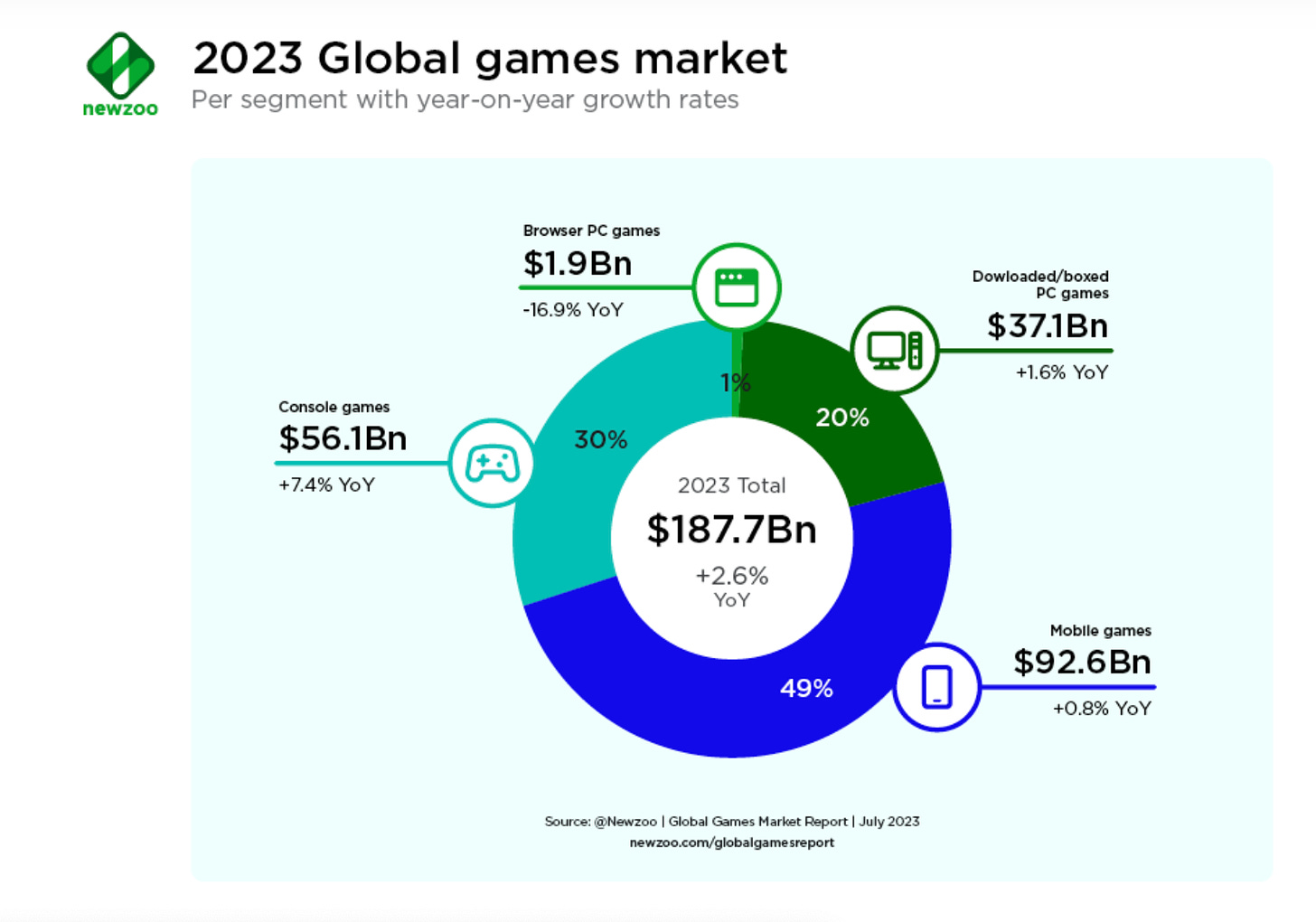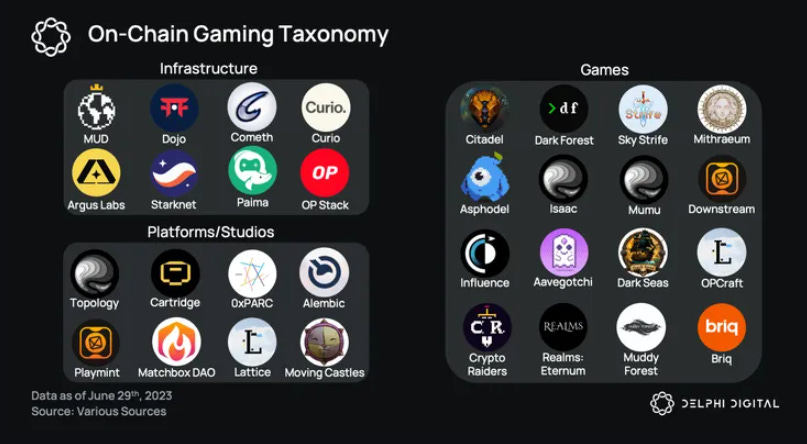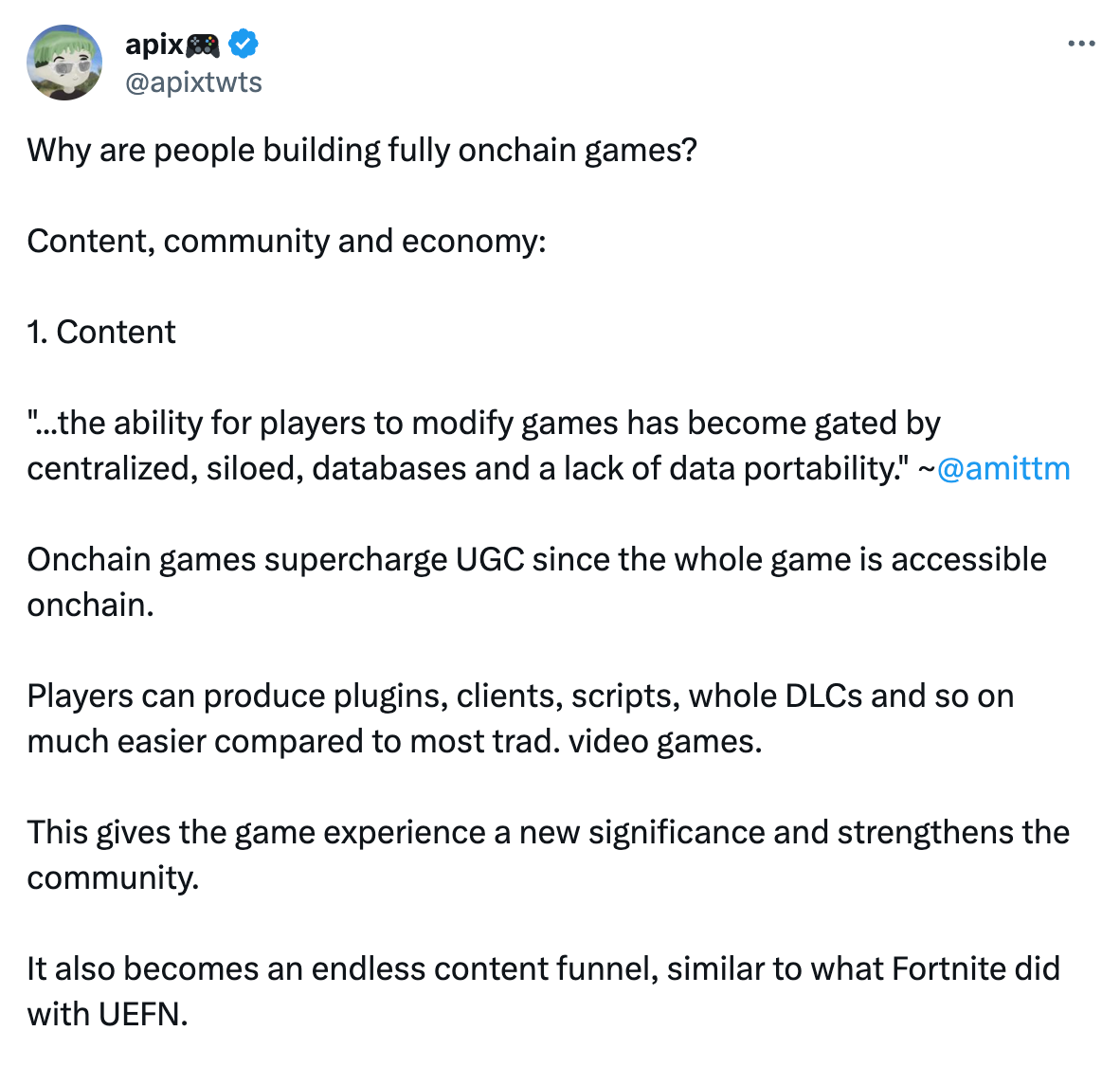I often get asked about my views on Web3 gaming. So I thought I’d outline my current thoughts in writing.
Let's set the record straight: I'm no gaming guru. This isn't an all-encompassing deep dive into the gaming world’s granular metrics like MAUs or D14s. Consider this a reflection of where I'm focusing my attention within the gaming space, based on my personal conversations and research.
Subscribe
Why gaming?
Lately, I’ve come around to the idea that gaming is one of the few sectors in crypto that has the raw power to be a game-changer (pun intended).
By that, I mean bringing in 10 million to 100 million+ daily active blockchain users within the next 2 years. Games have the potential to do this because (1) they are inherently social — not just multiplayer games but even single-player games like Elden Ring and God of War become communal through online communities and content, and (2) they have a real propensity to go viral (remember Flappy Birds?)
- Finance is undoubtedly crucial — it will be integrated with the backend of our financial infrastructure and bring benefits to everyone — but most people aren’t interested in finance.
- Art has found a good product-market fit through NFTs. But art is ultimately a niche market, catering to a well-heeled audience. Its market growth and journey to broader acceptance is likely to be a slow burn.

Global Games Market Report 2023 / Newzoo
Gaming on the other hand.. is fun, engaging, and most importantly, it's universally enjoyable. The numbers don’t lie:
- In 2023, there are 3 billion+ active video game players worldwide. Mobile gaming is the most popular gaming platform, with over 1.7 billion mobile gamers worldwide.
- The global gaming market is worth ~$385 billion.
- The Asia-Pacific region is the largest gaming market, accounting for nearly half of all global gaming revenue, followed by US and China.
- In 2023, the average gamer is 36 years old and has been gaming for 15 years.
One killer Web3 game is all we need to set things in motion.
Building a Camry or Spaceship?
I see two divergent approaches to Web3 gaming today.
- Building a Toyota Camry — Making games that are fun to play first and foremost, and then layering on blockchain and NFTs
- Building a Spaceship — Leaning entirely into NFTs and blockchain from the beginning of the game design process.
I’ll explain the analogies as we go along.
The Toyota Camry — Legacy Game Studios
The legendary VC Vinod Khosla once said, "Startups drive the vast majority of innovation, not the institutional incumbents."
But an equally wise observation from my good friend Kiet from thecoreloop has resonated with me: He says that making a good game is much more of an art than a science. you need to have an intimate understanding of the industry's intricacies in order to succeed. It’s something legacy studios have honed over time.
And so I pay attention to what the behemoths of the gaming industry are doing in web3 since they have proven successful at making great games.

Building a car is straightforward, we know exactly how to do it, and it’s been done many times before. The Toyota Camry, with its reliability and performance, was meticulously designed to stand out in the crowded automotive market. It made its debut in 1980, and there have been 8 generations of the Camry so far. Toyota invests around 3-5 years of research, design iteration, testing, and manufacturing coordination to develop each new Camry model generation from start to finish. It’s the 5th best-selling car in the US today with 300,000+ yearly sales.

Like building Camrys, the gaming behemoths are focusing on what they’ve been doing best all these years—creating compelling games—before weaving in blockchain and NFTs as value-added features. Crypto is not the main selling point here but it’s like adding a turbocharger to your Camry. It can enhance performance and provide a boost.
Several major gaming studios are diving headfirst into the world of Web3 gaming, often by adapting their existing, successful titles. The reasoning is sound: Developing a Web3 game requires studios to simultaneously nail two key elements. (1) they must craft an engaging and enjoyable game experience, and (2), they need to get the digital economy within the game right.
By leveraging established IPs that already have a strong player base and a track record of engaging gameplay, these studios effectively de-risk on (1). This allows them to channel their focus primarily on (2), optimizing the economic gameplay.
Let me highlight 4 examples of legacy gaming studios entering Web3:
- Take-Two/Zynga → Sugartown (this is new IP)
- Square Enix → Symbiogenesis
- Nexon → Maple Story N
- CCP games → EVE online
On Sugartown, this is what my friend Bharat Krymo had to say:

Source: Friend Tech chats 22 September 2023
Conversely, Square Enix's venture into blockchain with Symbiogenesis feels somewhat stuck in the past, as if it was conceived during the NFT bull market when royalties were still a big thing and haven't quite evolved since. I've been a Final Fantasy aficionado since my youth. Heck, I bought a PS5 to play the recent FF16.
Maple Story N is an interesting one. It’s doubling down on ownership, where in-game items are NFTs, making them inherently scarce and composable. Furthermore, they're making a push towards user-generated content by allowing players to craft their own in-game items and bring them to market,
Introducing blockchain assets or rails into existing games with a large and active player base, like MapleStory or CS:GO, can incrementally add value via more meaningful player loops or additional revenue streams…
…NEXON is best positioned to sustain development on MapleStory Universe and set the bar for how blockchain can be leveraged in a way that isn’t just a cash grab.
Delphi Digital/JACL, “Why Asia will lead Web3 Gaming”
As more experiments unfold, the first studio to crack the right formula could find itself with a pot of gold.
The Spaceship: Fully On-Chain Gaming
A friend who runs a large gaming guild once said to me: “If you're only lightly integrating NFTs or tokens into a Web3 game, you're not pushing the envelope far enough. You might as well go build a normal game. The successful ones will be those who go all-in on the blockchain”
And so we have fully on-chain games, or "autonomous worlds" (AW), which are to gaming what SpaceX is to travel in the early 2000s.
AWs are akin to building a spaceship.
Building a rocket/spaceship is a complex endeavor and requires years of research, development, and testing. The Falcon 1 rocket took 7+ years of development before a successful flight and cost SpaceX >$100M, nearly bankrupting it in the process.

Every element, from the fuel to the life-support systems, is integral to the journey and involves complex engineering and precision. They need to be thoroughly tested and refined to withstand the harsh conditions of space. Developing the propulsion system is one of the most challenging aspects of the process. It requires innovative solutions to generate the necessary thrust to escape Earth's gravity.
Similarly, AWs are doing something we’ve never done before. It is wholly committed to the blockchain stack. It uses the blockchain to store all its data and smart contracts to enact the game logic and rules in a client-agnostic manner.

Why do we want to go through all this pain of putting games on-chain? I can think of 3 reasons:
- Eliminate platform risk: A friend of mine was a top-tier Overwatch player in China. She spent seven years mastering the game. However, when Blizzard ended its 14-year licensing agreement with NetEase, her gaming career came to an abrupt halt. AWs mitigate such risks. As long as the blockchain network is operational, the game lives on—immune to the whims of centralized authorities. That friend? She has since transitioned into building her own on-chain gaming studio.
- Endless user-generated content: UGC is the buzzword these days, for good reason. People love being part of the creative process. And games benefit from having new content all the time. In AWs, the community isn't just a passive consumer; it's an active participant. Gamers can create tools and enhancements — permissionless modding — while effectively blurring the lines between players and developers. This collaborative ecosystem can enrich the gaming experience.
- Skyscraping (composability): The modular nature of AWs is another standout feature. Developers can focus on building new things rather than reinventing the wheel, using modules already created and used in previous on-chain games (for example, an on-chain leveling module or a quests module). And imagine the possibility of integrating disparate universes—like Marvel and DC Comics—into a single gaming environment. While licensing hurdles may exist, the technology itself won’t be a barrier.
A game still needs to captivate its audience through engaging gameplay. Yet when these 3 elements combine — a holy trinity of sorts — it heralds in a novel gaming primitive that holds immense future potential in time to come.
apix seems to share similar views:

The addressable market for this new form of gaming is still unknown (just like the uncertain Space market in the early days of SpaceX). Will it appeal solely to today's crypto natives, or does it have the potential to break into the mainstream? Only time will tell. And it might take a while.
One thing is for sure: I like new primitives in crypto. While the road ahead is uncertain, the early adopters could capture a lot of value if the sector booms (think Axie Infinity and the Play-to-Earn model).
Pro-tip: I’m watching Pirate Nation closely.
The In-Betweens
What about Illuvium, Parallel, and other crypto-native game studios?
I have mixed feelings.
Making a Web3 game is difficult. Two very distinct sets of skills are required:
- Crypto-expertise: Not only technical knowledge of blockchains but also understanding of crypto-native behaviors, tokenomics, and economy design
- Game design and distribution: this arena is largely dominated by Web2 practices. The complexities here include designing compelling incentive loops, optimizing player spending, and mastering performance marketing.
Many web3-native gaming teams today are very strong in (1) but have a questionable competitive advantage in (2). Especially when you consider that they are up against huge, well-capitalized Web2 studios with strong existing IPs. Teams with a heavy track record in web2 gaming and have raised sufficient funds could succeed (Limit Break seems to fit this criteria, despite the Super Bowl fiasco)
Crypto-native Web3 game studios are often building a new IP from scratch which is a challenging task. Some of them have launched tokens with 8 to 9-figure market caps, which price in a hefty amount of user adoption.
In conclusion, Web3 gaming is at a pivotal crossroads. We have incumbent giants with established IPs and a deep understanding of game design & distribution. And we have crypto-native teams that are pushing the frontiers of on-chain gaming. One thing is clear, those who can master the blend of old and new are the ones poised for mega success.
Some insightful web3 gaming reads:
Crypto Gaming: A Most Practical Thesis by Arad (Aug 2022)
To Sail beyond the liquidity sunset of taxation-based Web3 games by Folius Venture (Feb 2023)
About Web 2.5 Gaming by Maverick Capital (Mar 2023)
A Primer for Fully On-Chain Games by JACL/Delphi Digital (Jun 2023)
















